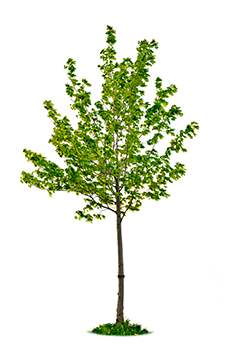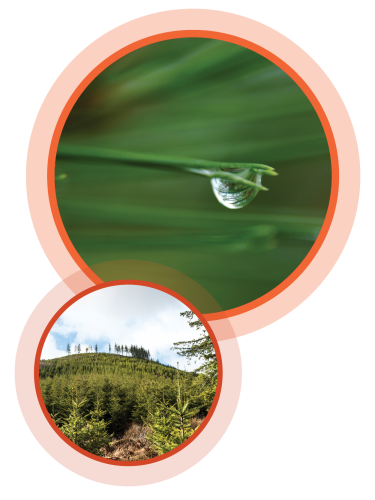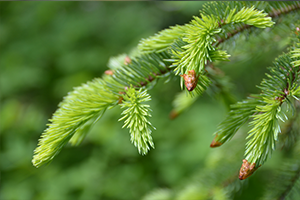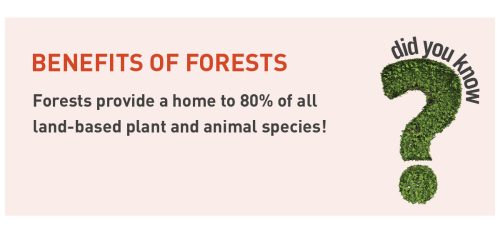 Key Concepts: The health of trees in a forest ecosystem depends on and is affected by many factors, including competition with other trees and plants for space, light, water/moisture, and nutrients. [PLT’s Forest Literacy Framework, Concept 1.B.7]
Key Concepts: The health of trees in a forest ecosystem depends on and is affected by many factors, including competition with other trees and plants for space, light, water/moisture, and nutrients. [PLT’s Forest Literacy Framework, Concept 1.B.7]
Objectives: Provide opportunities and materials for learners to:
- Model how trees compete to meet their essential needs.
- Describe how varying amounts of light, water, and nutrients affect tree growth.
Session Time: 50 minutes for tree planting
Setting: Indoors or Outdoors
 What do trees need so they can grow? Trees produce their own “food” by using the chlorophyll in their leaves to capture energy from the sun in a process called photosynthesis, which uses carbon dioxide from the air and water from rainfall. If trees don’t get enough sunlight, air, water, or nutrients, they may grow slowly or even die.
What do trees need so they can grow? Trees produce their own “food” by using the chlorophyll in their leaves to capture energy from the sun in a process called photosynthesis, which uses carbon dioxide from the air and water from rainfall. If trees don’t get enough sunlight, air, water, or nutrients, they may grow slowly or even die.
Forest managers use a variety of strategies to ensure that trees get what they need to thrive. One example is a process called selective thinning that removes some of the trees, allowing more water, sunlight, and nutrients for the trees that remain. Controlling the underbrush and other vegetation can also reduce competition for limited resources. Since different tree species need different conditions to thrive, forest managers make future forest decisions based on the species of trees, and their age and lifespan to make decisions relative to tree growth or harvest.
Materials:
8” x 10” (20 cm x 25 cm) pieces of paper or white paper plates; 4–6 different colors of poker chips, or construction paper; large sheet of paper or other means for recording group results.
Get Ready:
Gather 4–6 different colors of math cubes, construction paper, or poker chips—such as blue, yellow, white, green, black, and red—with enough of each color so that each learner can have two cubes or chips. Keep the colors separate to start. As an alternative, cut 3” x 3” (7.6 cm x 7.6 cm) squares out of different colors of construction paper.
 Introduce
Introduce
Ask learners what they think trees need to grow. (They might mention water, sunlight, air, or nutrients. You may want to point out that most of a tree’s mass is made of carbon, which comes from the air.) Ask: What do you think would happen if a tree doesn’t get all the things it needs?
Experience
-
-
To model what happens when a tree doesn’t get everything it needs, have learners spread out about 3 feet (90 cm) apart and stand (or sit in chairs) on a piece of paper or paper plate. They each represent a tree whose goal is to get as many needs as possible. They must stay planted on their paper and cannot slide it along the floor or step off it.
-
Equally distribute the “tree resources” (colored poker chips, paper squares, etc.) around the learners so that the resources are about 1–2 feet (30–60 cm) apart. Explain that each represents a tree need. Assign each need a color (e.g., blue = water, yellow = sunlight, white = carbon from the air, and green = a nutrient such as nitrogen or phosphorus).
-
Give a signal to start. Have “trees” reach to gather the resources they need. Use the following quantity requirements to determine how many of the group’s trees are growing well or poorly: three or more of each resource means superior growth, two of each means average growth, and one or fewer of each means poor growth.
-
Discuss: What might happen to a real tree that can’t meet one or more of its needs? (It might grow slowly or eventually die. Point out that different species of trees have different needs; some tree species might need more water than others, for example.)
-
Conduct additional rounds, using one or more of the following conditions:
-
-
- Trees stand or sit closer together on their papers (representing more competition).
- Fewer water resources (representing a drought).
- Fewer sunlight resources (representing overcrowding for young trees).
- Fewer nutrient resources (representing poor-quality soil).
- Add a new colored resource to represent fire (red) or an insect infestation (black), such as bark beetles or gypsy moths. How might this new element affect the trees? Discuss that some trees may not be affected, for example, Longleaf pine, may be relatively unaffected by fire
Connect
Challenge learners to look for outside examples of the different scenarios they modeled in the activity. For example, they may see groups of trees growing close together (and not getting enough sunlight) or a tree planted close to the pavement (and not getting enough water or space).
Discuss: What does this activity model? What does the model tell us about strategies for managing forests (for example, thinning trees that are too close together)?
TAKE ACTION!
Help the group begin a list of jobs that help to support forest resources, such as forester or water quality specialist. Encourage learners to research one of these jobs to learn more about it.
 Through an active modeling exercise, learners explore how trees compete with each other for nutrients, sunlight, space, and water. In this activity, learners model how trees compete to meet their essential needs and describe how varying amounts of light, water, and nutrients affect tree growth.
Through an active modeling exercise, learners explore how trees compete with each other for nutrients, sunlight, space, and water. In this activity, learners model how trees compete to meet their essential needs and describe how varying amounts of light, water, and nutrients affect tree growth.

 Key Concepts: The health of trees in a forest ecosystem depends on and is affected by many factors, including competition with other trees and plants for space, light, water/moisture, and nutrients. [PLT’s Forest Literacy Framework, Concept 1.B.7]
Key Concepts: The health of trees in a forest ecosystem depends on and is affected by many factors, including competition with other trees and plants for space, light, water/moisture, and nutrients. [PLT’s Forest Literacy Framework, Concept 1.B.7] What do trees need so they can grow? Trees produce their own “food” by using the chlorophyll in their leaves to capture energy from the sun in a process called photosynthesis, which uses carbon dioxide from the air and water from rainfall. If trees don’t get enough sunlight, air, water, or nutrients, they may grow slowly or even die.
What do trees need so they can grow? Trees produce their own “food” by using the chlorophyll in their leaves to capture energy from the sun in a process called photosynthesis, which uses carbon dioxide from the air and water from rainfall. If trees don’t get enough sunlight, air, water, or nutrients, they may grow slowly or even die. Introduce
Introduce